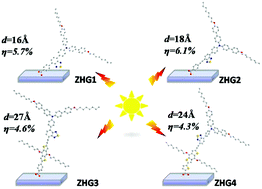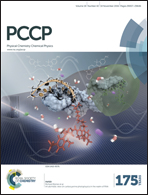Insight into the effects of modifying π-bridges on the performance of dye-sensitized solar cells containing triphenylamine dyes†
Abstract
Herein we prepare four novel D–π–A dyes based on triphenylamine (ZHG1, ZHG2, ZHG3 and ZHG4) by modifying the π-bridges. Compared with ZHG1, the power conversion efficiency (PCE) of ZHG2 is improved to 6.1% after the introduction of ethynyl. But further extension of the conjugation of the π-bridges by introducing the chromophore 4,8-bis(n-octyloxy)-benzo[1,2-b:4,5-b′]dithiophene (BDT) into ZHG3 conversely decreases the PCE to 4.6%. Improving the coplanarity by replacing cyclobenzene with thiophene in ZHG4 after introducing BDT further decreases the PCE of ZHG4 to 4.3%. Theoretical calculations indicate that the LUMOs of ZHG3 and ZHG4 were mainly delocalized over benzothiadiazole which is far from the anchoring groups. Cyclic voltammetry experiments indicate that the LUMO energy levels of ZHG3 and ZHG4 are lower than those of ZHG1 and ZHG2. Both of these results affect the ability to inject electrons into the TiO2 conduction band. X-ray photoelectron spectroscopy (XPS) analysis shows that the mean thickness of the dye coverage for ZHG1, ZHG2, ZHG3 and ZHG4 is 16 Å, 18 Å, 27 Å and 24 Å, respectively. So the tilt angle of the dye backbone anchored on the TiO2 film is in the order of ZHG1 > ZHG2 > ZHG4 > ZHG3, which is consistent with the dye coverage of the outermost TiO2 surfaces. This result indicates that the intermolecular π–π aggregation in ZHG3 and ZHG4 with overlong π-bridges is more serious compared with that in ZHG1 and ZHG2. Perhaps the above two factors are the reason that the PCEs of ZHG3 and ZHG4 are lower than those of ZHG1 and ZHG2. So it is very important to find a balance point between the electron injection ability, intermolecular π–π aggregation and the expansion of the light absorption range.



 Please wait while we load your content...
Please wait while we load your content...